Technical Newsletter
Issue 39
Bio-Retention Solution using Allan Block
Washington Regional Medical Center (WRMS) in Fayetteville is the only not-for-profit, community-owned and locally governed healthcare system in Northwest Arkansas. The Fayetteville hospital completed a $60 million, 100,000 ft2 (9,300 m2) expansion in 2016. Another $44 million expansion is in the works, scheduled to be completed in early 2019. With it, came an opportunity to treat and regulate the increased runoff from the post-developed parking, access drive and building area. The solution to this problem was created by way of a bio-retention basin.
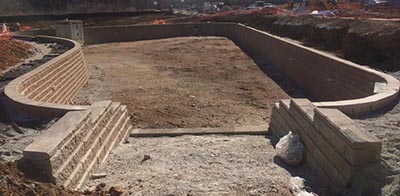
For this project, the Center owners worked with USI Consulting Engineers to design the Allan Block walls. USI Consulting Engineers found Allan Block Classic blocks to be an efficient and effective solution to provide a perimeter to this bio-retention basin and create as much usable space as possible while providing the quality aesthetics that the medical community demanded. They knew that the hollow core of the Allan Block unit, in conjunction with well-graded wall rock, could provide a perfect structural solution to water applications such as this one and increase the water storage volume of the basin.
The pond needed to be designed for an outflow at a 100-year storm event of 15.25 ft3/s (0.43 m3/s).The wall itself has been designed to reach higher than a 1-year high water level, and a berm has been created behind the wall which reaches higher than the 100-year high water elevation.
Wall Rock, as well as toe and heel drains, have been placed behind the wall to provide proper drainage of excess water and prevent any hydrostatic pressure building inside of the wall over time.
Second Nature Landscapes, Inc., a certified Allan Block wall installer, was contracted to build the walls. The wall construction was separated into two “phases”. First, the entire wall was constructed to 5 courses above grade. It was after this point that the more detailed work had to be done, and the remainder of the wall was built. Modifications had to be made at several locations to allow for inlets from existing storm sewer systems to discharge into the basin.
Discharged flows are regulated at the basin outlet structure with orifices for the channel protection volume, and overbank flood protection, and an open top with a grate for the extreme flood protection.
The Allan Block retaining walls offered an excellent and aesthetically pleasing solution to space limitations and grade change surrounding bio-retention basins. Now WRMS has the space to expand and handle the increased water run off effectively.
What is a Bio-Retention Pond
A bio-retention pond is just one of many water applications that can be constructed using Allan Block products. When a wall is constructed to be a water application, extra steps need to be taken. The wall rock should be placed to the limits of the geogrid lengths up to a height equal to 12 in. (30 cm) higher than the determined high water mark. The drain pipe should also be raised to the low water elevation to aid in the evacuation of water from the reinforced mass as water level fluctuates. Finally, embankment protection fabric should be used under the infill mass and up the back of the infill mass to a height of 12 in. (30 cm) higher than the determined high water mark.
Consideration for Bio-Retention Ponds
The bio-retention area is graded to divert excess runoff away from itself. Stored water in the bio-retention planting soil exfiltrates over a period of days into the underlying soils. As you saw in the cover project, this is where Allan Block retaining walls are being used, to help grade the site for proper drainage and increase storage capacity. However, anybody familiar with the industry knows that water is the #1 enemy of all retaining walls. Therefore, it is very important to understand the design requirements of the bioretention area and handle the water properly. For complete information see the full Tech Sheet.
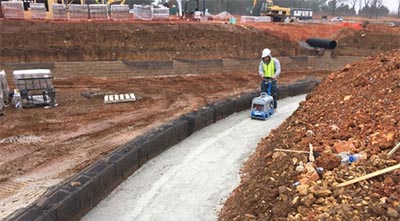
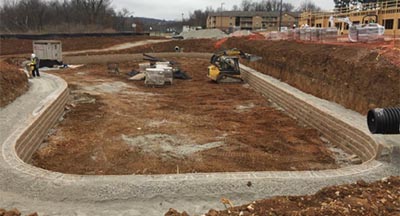
Retaining Wall Considerations
Location: The location of the bio-retention pond in relation to the retaining wall is crucial. When we see these applications below the wall, since land is a premium, the Allan Block Wall is used to create the pond without sloping the sides. For this reason, sizing must be considered. When designing a bioretention area, the designer needs to first determine the intended purpose of the pond, for example:- What are the site requirements for water quality and quantity control? Will the bio-retention pond be used to address both water quantity and quality or just one of the issues?
- What design storm is required to meet the storm water management criteria of the city, county, state or province. An example is handling the first 6 inches (15 cm) of rainfall during a 24-hour period.
- Is the facility used independently of other practices or is it part of the treatment plan approach?
Very seldom have we seen the application placed above a segmental retaining wall. Since the ponds are designed to retain water, it is not desirable to have them located immediately behind the wall. In good practice, they should be located behind the back of the wall at least 100% the height of the wall.
Water Management: Water is going to be present in front of the wall. Therefore, water elevations need to be understood so the retaining wall can be engineered to accommodate them, very similar to the standard water applications that have been used in the past. These considerations are highlighted in Chapter 5 of the Best Practices for SRW Design Manual. These include:
- Wall Rock placed behind the wall within the entire infill area to a height extending at least 1 ft (30 cm) above the potential high-water elevation.
- Embankment protection fabric should be used under and behind the infill mass to a height of 1 ft (30 cm) higher than the high-water mark.
- Drain pipe placement may be job dependent, but there are two options to consider. If there is an underdrain to the bio-retention pond, the drain could be placed at the bottom of the wall. With no drain, one should consider moving the pipe above the soil media.

Figure A: Bio-Retention Typical Reinforced Wall Detail High Water Level (HWL)
Embedment: Maintenance might require removal of the soil planting media if it gets clogged with sediment from the water runoff. Therefore, it is recommended that the block be embedded below that layer (Figure B.), or structural fill be placed in front of the block that will not be removed (Figure C.). Often times, the block is embedded at the same elevation as the drainage layer.
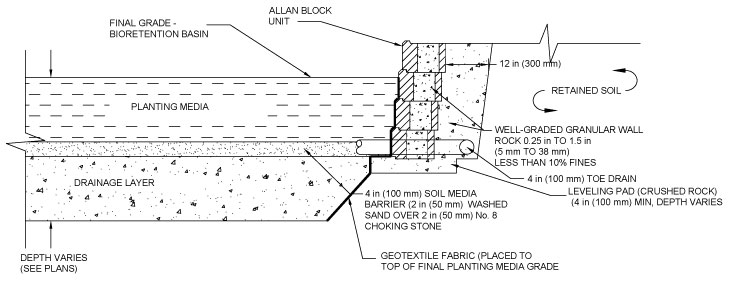
Figure B: Bio-Retention Typical Gravity Wall Detail A

Figure C: Bio-Retention Typical Gravity Wall Detail B
Use AB Walls 3D to Create Exportable Models
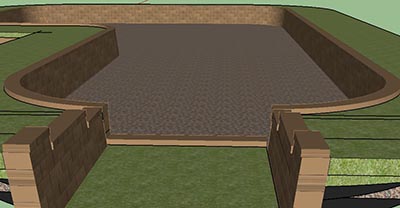
Having trouble visualizing how a retaining wall will fit into your site? Our AB Walls 3D Design Software now allows you to export your designs to 3D using SketchUp. This is what you can now see before the first scoop of dirt has even been moved!
See how you can save hours of time and have a professional visualization. See where geogrid placement will land behind a wall to catch potential problems or create models that are BIM compliant and more.
For more information and to attend a online webinar, check out our ABU Online courses.
ABU Online

In addition to and in support of local market education with our production partners, we have recently started an online platform for education on various site solutions including AB Fence and AB SRWs. These events will be the last Thursday of each month at 10 AM and 2 PM CST and many will provide continuing education opportunities. Topics will range from SRW Engineering Principles, No-Fines Concrete, GRS-IBS, Basic Design and Build of AB Fence, AB Walls 15 Design software among many others. Be sure to check out our ABU Online training opportunities.


